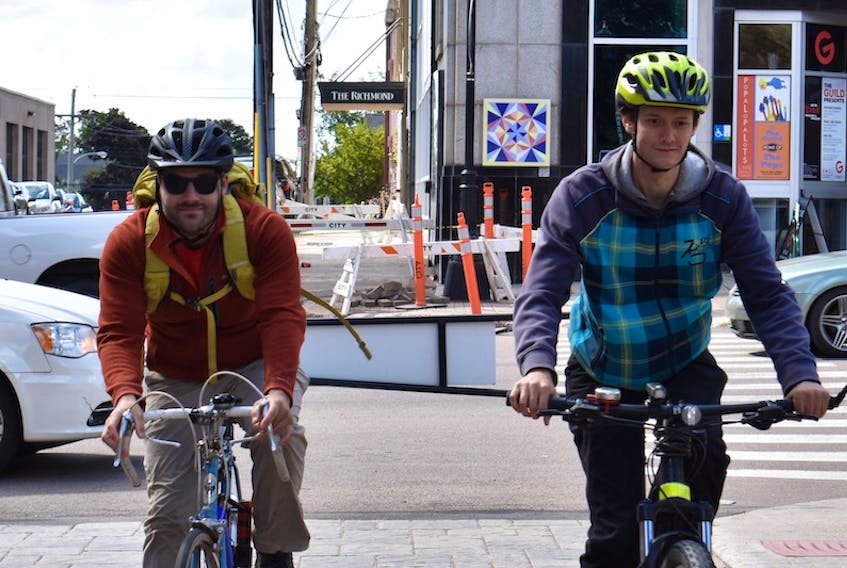As active transportation becomes more prevalent across P.E.I. and the number of e-bikes increases, it's time legislation catches up, say cycling advocates.
Isaac Williams and Mitch Underhay, with the group Bike Friendly Charlottetown, say the Highway Traffic Act is confusing for e-bike users.
While proper e-bikes — bicycles with electric motors referred to as power-assisted bicycles — don’t require a licence to operate in P.E.I., language in the Highway Traffic Act suggests they do.
Under the definition for “motorcycle,” it says it “includes a bicycle with a motor attached” and the definition for moped or motor-assisted pedal bicycle includes vehicles “provided with an electric motor.”
Williams and Underhay don't want to see e-bikes classed differently than other bicycles because they encourage bike use and increase accessibility.
“The intention of the technology is not to create a new class of vehicle for the road … the goal is to blend right in," said Williams.
“We basically want to encourage their use. We don’t want to put up barriers and we want to make sure they’re safe," said Underhay.
But Graham Miner, director of Highway Safety, says proper e-bikes don’t fall actually under the definition of a motor vehicle, as they require muscular power to operate.
“Generally, what we’ve been doing here with e-bikes is if the principle means of power is you can pedal them … we haven’t been doing anything with those other than saying ‘do we need to do something with them?’”
Miner says there is more to be done to clarify the act.
“What we’re strongly looking at — of course COVID slowed everything down in this area — … what we were going to do was get a larger group together to start talking about, in broad strokes, motorized personal mobility devices.”
By this, Miner means devices which fall outside the federal regulations for e-bikes.
One of the larger issues with e-bikes is how they’ll fit within the cycling infrastructure and culture already on the Island, especially as active transportation becomes more prevalent and the number of e-bikes increases.
It’s a problem Miner thinks is best solved with better regulations. He hopes a first draft will be done early next year, he said.
“There’s certainly a need for it and I would suggest the sooner the better, rather than waiting and waiting for more of these devices.”
Federal regulations of e-bikes from Canada's Motor Vehicle Safety Regulations:
power-assisted bicycle means a vehicle that:
(a) has steering handlebars and is equipped with pedals,
(b) is designed to travel on not more than three wheels in contact with the ground,
(c) is capable of being propelled by muscular power,
(d) has one or more electric motors that have, singly or in combination, the following characteristics:
(i) it has a total continuous power output rating, measured at the shaft of each motor, of 500 W or less,
(ii) if it is engaged by the use of muscular power, power assistance immediately ceases when the muscular power ceases,
(iii) if it is engaged by the use of an accelerator controller, power assistance immediately ceases when the brakes are applied, and
(iv) it is incapable of providing further assistance when the bicycle attains a speed of 32 km/h on level ground,
(e) bears a label that is permanently affixed by the manufacturer and appears in a conspicuous location stating, in both official languages, that the vehicle is a power-assisted bicycle as defined in this subsection, and
(f) has one of the following safety features,
(i) an enabling mechanism to turn the electric motor on and off that is separate from the accelerator controller and fitted in such a manner that it is operable by the driver, or
(ii) a mechanism that prevents the motor from being engaged before the bicycle attains a speed of 3 km/h; (bicyclette assistée)
Provincial definitions from Motor Vehicle Safety Act:
(a.1) “bicycle” means a two-wheeled device propelled by human power on which a person may ride, and includes a device prescribed to be a bicycle, but does not include a moped, a motor assisted pedal bicycle or a device prescribed not to be a bicycle;
(k) “motorcycle” means a motor vehicle, other than a tractor, having a saddle for the use of the rider and designed to travel with not more than three wheels in contact with the ground and includes a bicycle with a motor attached and a motor scooter;
(k.1) “motor vehicle” means a vehicle that is powered, drawn, propelled or driven by any means other than muscular power, but does not include
(i) a vehicle of a railway that operates on rails, or
(ii) a moped, except that for the purpose of Part XI, a moped is deemed to be a motor vehicle;
(k.2) “moped” or “motor assisted pedal bicycle” means a vehicle that
(i) is provided with an electric motor or a motor having a piston displacement no greater than fifty cubic centimeters,
(ii) is not capable of obtaining speed of greater than 50 km/h on the level when driven by a person weighing 60 kg, and
(iii) has no more than three wheels in contact with the ground;









